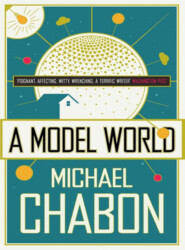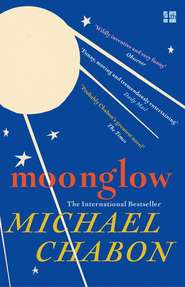По всем вопросам обращайтесь на: info@litportal.ru
(©) 2003-2024.
✖
The Amazing Adventures of Kavalier and Clay
Автор
Год написания книги
2018
Настройки чтения
Размер шрифта
Высота строк
Поля
“Boys!” called Mrs. Klayman from the kitchen. “Breakfast.”
“Just don’t say anything about any of this to my mother,” Sammy said. “And don’t tell her I’m changing my name.”
They went out to the laminate table in the kitchen and sat down in two of the padded chrome chairs. Bubbie, who had never met any of her Czech progeny, was sitting beside Joe, ignoring him completely. She had encountered, for better or worse, so many human beings since 1846 that she seemed to have lost the inclination, perhaps even the ability, to acknowledge faces or events that dated from any time after the Great War, when she had performed the incomparable feat of leaving Lemberg, the city of her birth, at the age of seventy, to come to America with the youngest of her eleven children. Sammy had never felt himself to be anything more, in Bubbie’s eyes, than a kind of vaguely beloved shadow from which the familiar features of dozens of earlier children and grandchildren, some of them dead sixty years, peered out. She was a large, boneless woman who draped herself like an old blanket over the chairs of the apartment, staring for hours with her gray eyes at ghosts, figments, recollections, and dust caught in oblique sunbeams, her arms streaked and pocked like relief maps of vast planets, her massive calves stuffed like forcemeat into lung-colored support hose. She was quixotically vain about her appearance and spent an hour each morning making up her face.
“Eat,” Ethel snapped, depositing in front of Joe a stack of black rectangles and a pool of yellow mucilage that she felt obliged to identify for him as toast and eggs. He popped a forkful into his mouth and chewed it with a circumspect expression behind which Sammy thought he detected a hint of genuine disgust.
Sammy performed the rapid series of operations—which combined elements of the folding of wet laundry, the shoveling of damp ashes, and the swallowing of a secret map on the point of capture by enemy troops—that passed, in his mother’s kitchen, for eating. Then he stood up, wiped his lips with the back of his hand, and pulled on his good wool blazer. “Come on, Joe, we gotta go.” He leaned down to embed a kiss in Bubbie’s suede cheek.
Joe dropped his spoon and, in the course of retrieving it, bumped his head on the table, hard. Bubbie cried out, and a minor commotion of silverware and chair-scraping ensued. Then Joe stood up, too, and delicately wiped his lips with his paper napkin. He smoothed it out when he finished and laid it on his empty plate.
“Delicious,” he said. “Thank you.”
“Here,” Ethel said, taking a neat tweed suit, on a hanger, from the back of a kitchen chair. “I pressed your suit and took the spots off your shirt.”
“Thank you, Aunt.”
Ethel put her arm around Joe’s hips and gave him a proud squeeze. “This one knows how to draw a lizard, that I can tell you.”
Sammy flushed. This was a reference to the peculiar difficulties Sammy had run into, the month before, with the Live Chameleon item (“Wear it on your lapel to amaze and impress!”) that Empire had recently added to their line. An apparently congenital lack of skill with reptiles was compounded by the fact that he had no idea what kind of reptile twenty-five cents sent to Empire Novelty would buy, since there were, in fact, no Live Chameleons in stock, and would not be until Shelly Anapol saw how many orders, if any, came in. Sammy had spent two nights poring over encyclopedias and library books, drawing hundreds of lizards, thin and fat, Old World and New, horned and hooded, and had ended up with something that looked a little like a flattened, bald squirrel. It was his sole failure since taking on the draftsmanship chores at Empire, but his mother, naturally, seemed to regard it as a signal one.
“He won’t have to draw any lizards, or cheap cameras, or any of that other dreck they sell,” said Sammy, and then added, forgetting the warning he had given Joe, “not if Anapol goes in for my plan.”
“What plan?” His mother narrowed her eyes.
“Comic books,” yelled Sammy, right to her face.
“Comic books!” She rolled her eyes.
“‘Comic books’?” said Joe. “What are these?”
“Trash,” said Ethel.
“What do you know about it?” Sammy said, taking hold of Joe’s arm. It was almost seven o’clock. Anapol docked your pay if you came in after eight. “There’s good money in comic books. I know a kid, Jerry Glovsky—” He pulled Joe toward the hallway that led to the foyer and the front door, knowing exactly what his mother was going to say next.
“Jerry Glovsky,” she said. “A fine example. He’s retarded. His parents are first cousins.”
“Don’t listen to her, Joe. I know what I’m talking about.”
“He doesn’t want to waste his time on any idiotic comic books.”
“It’s not your business,” Sammy hissed, “what he does. Is it?”
This, as Sammy had known it would, shut her right up. The question of something being one’s business or not held a central position in the ethics of Ethel Klayman, whose major tenet was the supreme importance of minding one’s own. Gossips, busybodies, and kibitzers were the fiends of her personal demonology. She was universally at odds with the neighbors, and suspicious, to the point of paranoia, of all visiting doctors, salesmen, municipal employees, synagogue committeemen, and tradespeople.
She turned now and looked at her nephew. “You want to draw comic books?” she asked him.
Joe stood there, head down, a shoulder against the door frame. While Sammy and Ethel argued, he had been affecting to study in polite embarrassment the low-pile, mustard-brown carpeting, but now he looked up, and it was Sammy’s turn to feel embarrassed. His cousin looked him up and down, with an expression that was both appraising and admonitory.
“Yes, Aunt,” he said. “I do. Only I have one question. What is a comic book?”
Sammy reached into his portfolio, pulled out a creased, well-thumbed copy of the latest issue of Action Comics, and handed it to his cousin.
In 1939 the American comic book, like the beavers and cockroaches of prehistory, was larger and, in its cumbersome way, more splendid than its modern descendant. It aspired to the dimensions of a slick magazine and to the thickness of a pulp, offering sixty-four pages of gaudy bulk (including the cover) for its ideal price of one thin dime. While the quality of its interior illustrations was generally execrable at best, its covers pretended to some of the skill and design of the slick, and to the brio of the pulp magazine. The comic book cover, in those early days, was a poster advertising a dream-movie, with a running time of two seconds, that flickered to life in the mind and unreeled in splendor just before one opened to the stapled packet of coarse paper inside and the lights came up. The covers were often hand-painted, rather than merely inked and colored, by men with solid reputations in the business, journeyman illustrators who could pull off accurate lab girls in chains and languid, detailed jungle jaguars and muscularly correct male bodies whose feet seemed really to carry their weight. Held in the hand, hefted, those early numbers of Wonder and Detective, with their chromatic crew of pirates, Hindu poisoners, and snap-brim avengers, their abundant typography at once stylish and crude, seem even today to promise adventure of a light but thoroughly nourishing variety. All too often, however, the scene depicted on the label bore no relation to the thin soup of material contained within. Inside the covers—whence today there wafts an inevitable flea-market smell of rot and nostalgia—the comic book of 1939 was, artistically and morphologically, in a far more primitive state. As with all mongrel art forms and pidgin languages, there was, in the beginning, a necessary, highly fertile period of genetic and grammatical confusion. Men who had been reading newspaper comic strips and pulp magazines for most of their lives, many of them young and inexperienced with the pencil, the ink brush, and the cruel time constraints of piecework, struggled to see beyond the strict spatial requirements of the newspaper strip, on the one hand, and the sheer overheated wordiness of the pulp on the other.
From the beginning, there was a tendency among educators, psychologists, and the general public to view the comic book as merely a debased offspring of the newspaper comic strip, then in the full flower of its since-faded glory, read by presidents and Pullman porters, a proud American cousin, in indigenous vitality and grace, of baseball and jazz. Some of the opprobrium and sense of embarrassment that would forever after attach itself to the comic book form was due to the way it at first inevitably suffered, even at its best, by comparison with the mannered splendor of Burne Hogarth, Alex Raymond, Hal Foster, and the other kings of funny-page draftsmanship, with the finely tuned humor and adultish irony of Li’l Abner, Krazy Kat, Abbie ’n’ Slats, with the steady, metrical storytelling of Gould and Gray and Gasoline Alley, or with the dizzying, never surpassed interplay of verbal and visual narrative in the work of Milton Caniff.
At first, and until very recently in 1939, comic books had in fact been nothing more than reprint digests of the more popular strips, uprooted from their newspaper homes and forced, not without violence and scissoring, between a pair of cheap glossy covers. The strips’ measured, three-to-four-panel pacing, with Friday cliffhangers and Monday recapitulations, suffered in the more spacious confines of the “funny book,” and what felt stately, thrilling, or hilarious when doled out in spoonfuls on a daily basis seemed a jerky, repetitive, static, and unnecessarily protracted business in the pages of, say, More Fun (1937), the first comic book that Sammy Klayman ever bought. Partly for this reason, but also to avoid paying the established syndicates for the reprint rights, the early publishers of comic books began to experiment with original content, hiring artists or packagers of artists to create their own characters and strips. These artists, if experienced, were not generally successful or talented; if they had talent, they lacked experience. Those in the latter category were mostly immigrants or immigrants’ children, or country boys right off the bus. They had dreams but, given their last names and lack of connections, no real chance of succeeding in the lofty world of Saturday Evening Post covers and ads for Mazda lightbulbs. Many of them, it must be said, could not even draw a realistic picture of the admittedly complicated bodily appendage with which they hoped to make their livings.
The drop-off in quality that followed the original-content revolution was immediate and precipitous. Lines grew tentative, poses awkward, compositions static, backgrounds nonexistent. Feet, notoriously difficult to draw in realistic depth, all but disappeared from the panels, and noses were reduced to the simplest variations on the twenty-second letter of the alphabet. Horses resembled barrel-chested, spindly dogs, and automobiles were carefully effaced with speed lines to disguise the fact that they lacked doors, were never drawn to scale, and all looked the same. Pretty women, as a requisite arrow in every boy cartoonist’s quiver, fared somewhat better, but the men tended to stand around in wrinkleless suits that looked stamped from stovepipe tin and in hats that appeared to weigh more than the automobiles, ill at ease, big-chinned, punching one another in their check-mark noses. Circus strong men, giant Hindu manservants, and breechclouted jungle lords invariably sported fanciful musculature, eyeceps and octoceps and beltoids, and abdomens like fifteen racked pool balls. Knees and elbows bent at painful, double-jointed angles. The color was murky at best, and at worst there was hardly any color at all. Sometimes everything was just two tones of red, or two of blue. But most of all, comic books suffered not from insufficient artwork—for there was considerable vitality here, too, and a collective Depression-born urge toward self-improvement, and even the occasional talented hard-luck competent pencilman—but from a bad case of the carbon copies. Everything was a version, sometimes hardly altered at all, of a newspaper strip or a pulp-radio hero. Radio’s Green Hornet spawned various colors of wasp, beetle, and bee; the Shadow was himself shadowed by a legion of suit-wearing, felt-hatted, lama-trained vigilantes; every villainess was a thinly disguised Dragon Lady. Consequently, the comic book, almost immediately upon its invention, or soon thereafter, began to languish, lacking purpose or distinction. There was nothing here one could not find done better, or cheaper, somewhere else (and on the radio one could have it for free).
Then, in June 1938, Superman appeared. He had been mailed to the offices of National Periodical Publications from Cleveland, by a couple of Jewish boys who had imbued him with the power of a hundred men, of a distant world, and of the full measure of their bespectacled adolescent hopefulness and desperation. The artist, Joe Shuster, while technically just barely apt, seemed to understand from the first that the big rectangular page of the comic book offered possibilities for pacing and composition that were mostly unavailable in the newspapers; he joined three panels vertically into one to display the full parabolic zest of one of Superman’s patented skyscraper-hops (the Man of Steel could not, at this point in his career, properly fly), and he chose his angles and arranged his figures with a certain cinematic flair. The writer, Jerome Siegel, had forged, through the smelting intensity of his fanatical love and compendious knowledge of the pulps and their antecedents, a magical alloy of several previous characters and archetypes from Samson to Doc Savage, one with its own unique properties of tensility, hardness, and luster. Though he had been conceived originally as a newspaper hero, Superman was born in the pages of a comic book, where he thrived, and after this miraculous parturition, the form finally began to emerge from its transitional funk, and to articulate a purpose for itself in the marketplace of ten-cent dreams: to express the lust for power and the gaudy sartorial taste of a race of powerless people with no leave to dress themselves. Comic books were Kid Stuff, pure and true, and they arrived at precisely the moment when the kids of America began, after ten years of terrible hardship, to find their pockets burdened with the occasional superfluous dime.
“That’s a comic book,” said Sammy.
“Big money you say,” Joe said, looking more doubtful than he had all morning.
“Fifty dollars a week. Maybe more.”
“Fifty dollars!” said Ethel, her usual tone of disbelief modified, it seemed to Sammy, by a wrinkle of uncertainty, as if the very patent outrageousness of the claim might be a guarantee of its veracity.
“Forty at least.”
Ethel folded her arms and stood there, chewing on her lower lip. Then she nodded. “I have to find you a better tie,” she said to Joe. She turned and went back into the apartment.
“Hey, Sam Clay,” Joe whispered, producing the neat little bundle, wrapped in a paper napkin, in which he had secreted his uneaten breakfast. He held it up with a little smile. “Where I can throw this?”
2 (#ulink_b52bb7b9-6a95-5984-a9b2-dc03464eb184)
THE OFFICES of the Empire Novelty Company, Inc., were on the fourth floor of the Kramler Building, in a hard-luck stretch of Twenty-fifth Street near Madison Square. A fourteen-story office block faced with stone the color of a stained shirt collar, its windows bearded with soot, ornamented with a smattering of moderne zigzags, the Kramler stood out as a lone gesture of commercial hopefulness in a block filled with low brick “taxpayers” (minimal structures generating just enough in rent to pay property taxes on the land they occupied), boarded-up woolens showrooms, and the moldering headquarters of benevolent societies that ministered to dwindling and scattered populations of immigrants from countries no longer on the map. It had been dedicated in late 1929, then repossessed by the lien-holding bank when the developer leaped from the window of his office on the fourteenth floor. In the ten years since, it had managed to attract a small but varied number of tenants, among them a publisher of sexy pulp magazines; a distributor of hairpieces, false beards, male corsets, and elevator shoes; and the East Coast booking agents for a third-rate midwestern circus; all of them attracted, as Shelly Anapol had been, by the cut-rate rents and a collegial atmosphere of rascality.
Despite the air of failure and disrepute that permeated the neighborhood, Sheldon P. Anapol—whose brother-in-law Jack Ashkenazy owned Racy Publications, Inc., on the Kramler’s seventh floor—was a talented businessman, likable and cruel. He had gone to work for Hyman Lazar, the founder of Empire Novelty, in 1914, at the age of twenty, as a penniless traveling salesman, and fifteen years later had saved enough to buy the company out from under Lazar when the latter ran afoul of his creditors. The combination of a hard-won cynicism, low overhead, an unstintingly shoddy product line, and the American boy’s unassuageable hunger for midget radios, X-ray spectacles, and joy buzzers had enabled Anapol not only to survive the Depression but to keep his two daughters in private school and to support or, as he liked to put it, invoking unconscious imagery of battleships and Cunard liners, to “float” his immense and expensive wife.
As with all great salesmen, Anapol’s past comprehended tragedy and disappointment. He was an orphan of pogrom and typhus, raised by unfeeling relations. His physical bulk, inherited from generations of slab-jawed, lumbering Anapols, had for much of his early life rendered him the butt of jokes and the object of women’s scorn. As a young man, he had played the violin well enough to hope for a musical career, until a hasty marriage and the subsequent upkeep on his two dreadnought daughters, Belle and Candace, forced him into a life of commercial traveling. All of this left him hardened, battered, rumpled, and addicted to the making of money, but not, somehow, embittered. He had always been welcome, during his days on the road, in the lonely shops of the dealers in jokes and novelties, men who were often in their third or fourth line of work and almost universally broken, after years of guessing and disaster, of the ability to know what was amusing and what was not. The unambiguously comical sight of Anapol, with his vast, unbuttoned suits and mismatched socks, his sad violinist’s eyes, modeling a blond horsehair wig or demonstrating a dentifrice that turned the teeth of victims black, had been the keystone of many a big sale in Wilkes-Barre or Pittsfield.
In the last decade, however, he had traveled no farther than Riverdale; and over the past year, following an intensification in his perennial “difficulties” with his wife, Anapol had rarely even left the Kramler Building. He had a bed and nightstand brought in from Macy’s, and he slept in his office, behind an old crewelwork coverlet draped over a length of clothesline. Sammy had received his first raise the previous fall when he found an empty pushboy’s clothes rack idling on Seventh Avenue one night and rolled it across town to serve as Anapol’s clothes closet. Anapol, who had read widely in the literature of sales and was in fact eternally at work on a treatise-cum-autobiography he referred to sometimes as The Science of Opportunity and other times, more ruefully, as Sorrow in My Sample Case, not only preached initiative but rewarded it, an ethos on which Sammy now pinned all his hopes.
“So talk,” said Anapol. He was wearing, as usual at this early hour, only socks, garters, and a pair of brightly patterned boxer shorts wide enough to qualify, Sammy thought, as a mural. He was bent over a tiny sink at the back of his office, shaving his face. He had been up, as every morning, since before dawn, settling on a move in one of the chess games he played by mail with men in Cincinnati, Fresno, and Zagreb; writing to other solitary lovers of Szymanowski whom he had organized into an international appreciation society; penning ill-concealed threats to particularly recalcitrant debtors in his creaky, vivid, half-grammatical prose in which there were hints of Jehovah and George Raft; and composing his daily letter to Maura Zell, his mistress, who was a chorine in the road company of Pearls of Broadway. He always waited until eight o’clock to begin his toilet, and seemed to set great store in the effect his half-naked imperial person had on his employees as they filed in for work. “What’s this idea of yours?”
“Let me ask you this first, Mr. Anapol,” Sammy said. He was standing, clutching his portfolio, on the threadbare oval of Chinese carpet that covered most of the wooden floor of Anapol’s office, a large room set off from the desks of Mavis Magid, Anapol’s secretary, and the five shipping, inventory, and account clerks by partitions of veneered presswood and glass. A hat rack, side chairs, and rolltop desk were all secondhand, scavenged in 1933 from the offices of a neighboring life-insurance company that went belly-up, and trucked on dollies down the hall to their present location. “What are they charging you over at National for the back cover of Action Comics this month?”
“No, let me ask you a question,” Anapol said. He stepped back from the mirror and tried, as he did every morning, to induce a few long strands of hair to lie flat across the bald top of his head. He had said nothing so far about Sammy’s portfolio, which Sammy had never before had the courage to show him. “Who is that kid sitting out there?”
Anapol did not turn around, and he hadn’t taken his eyes from the tiny shaving mirror since Sammy had come into the room, but he could see Joe in the mirror. Joe and Sammy were sitting back to back, separated by the glass and wood partition that divided Anapol’s office from the rest of his empire. Sammy craned around to get a look at his cousin. There was a pine drawing board on Joe’s lap, a sketchpad, and some pencils. On the chair beside him lay a cheap pasteboard portfolio they had bought in a five-and-dime on Broadway. The idea was for Joe to fill it quickly with exciting sketches of muscular heroes while Sammy pitched his idea to Anapol and played for time. “You’ll have to work fast,” he had told Joe, and Joe had assured him that in ten minutes he would have assembled an entire pantheon of crime-fighters in tights. But then on the way in, as Sammy was talking up Mavis Magid, Joe had wasted precious minutes rummaging through the shipment of Amazing Midget Radios whose arrival yesterday morning from Japan had sent Anapol into a rage; the whole shipment was defective and, even by his relaxed standards, unsaleable.
“That’s my cousin Joe,” said Sammy, sneaking another glance over his shoulder. Joe was bent over his work, staring at his fingers and craning his head slowly from left to right, as if some invisible force beam from his eyes were dragging the tip of the pencil across the page. He was sketching in the bulge of a mighty shoulder that was connected to a thick left arm. Other than this arm and a number of faint, cryptic guidelines, there was nothing on the page. “My mother’s nephew.”
“He’s a foreigner? Where’s he from?”











